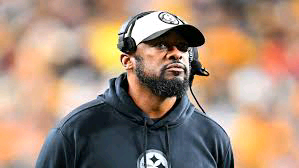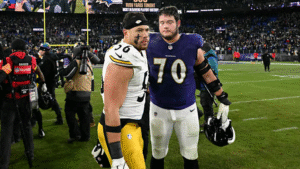
A Cautionary Tale: The Drone Incident at M&T Bank Stadium
I. The Incident at the Wild Card Game
- Background of the Game:
In January, an intense NFL Wild Card playoff matchup took place at Baltimore’s M&T Bank Stadium. The visiting team, the Pittsburgh Steelers, faced off against their Baltimore rivals, the Ravens. During one of the most highly anticipated games of the season, an incident occurred that briefly stopped the action—not due to a play on the field, but due to airborne interference. - Drone Over the Stadium:
A remote-controlled drone was flown above the stadium during the game. Federal airspace regulations restrict aircraft—drones included—from operating within three nautical miles of major sporting events like playoff games. Despite this restriction, the drone made its way into the event’s restricted airspace, hovering over spectators, players, and officials. 
- Halting the Game:
Once the drone appeared in the sky above M&T Bank Stadium, officials decided to pause the matchup for several minutes. The temporary pause was crucial to ensure spectator safety, as drones can pose significant hazards if they crash or lose control in crowded public areas.
II. Identifying the Operator
- Federal Involvement:
Both the Maryland State Police and the FBI were immediately alerted and deeply involved in the ongoing investigation. These agencies worked jointly to track the drone’s flight path through radar and other detection technologies, ultimately closing in on the individual responsible. - Apprehending the Culprit:
After thorough investigation, authorities identified the pilot of the drone as 43‑year‑old Alexis Perez Suarez, a native of Baltimore. Prosecutors charged him with violating federal aviation regulations, specifically for operating an unauthorized aircraft over a protected event.
III. Legal Resolution and Sentencing
- Guilty Plea:
In court, Perez Suarez entered a plea of guilty. Acknowledging his wrongdoing under the law, he admitted to flying the drone into the restricted airspace during the playoff game. - Sentencing Details:
The court handed down a sentence comprising:- One year of probation,
- A requirement to complete 100 hours of community service, and
- A fine of $500.
These penalties serve as a deterrent to anyone considering interfering with regulated airspace during significant public events.
IV. Official Response from the FBI
- Statement by Amanda M. Koldjeski:
Acting Special Agent in Charge at the FBI, Amanda M. Koldjeski, emphasized the severity of Perez Suarez’s actions in an official statement. According to Koldjeski:“It is not just irresponsible and reckless, but illegal to fly a drone over a major sporting event such as a Ravens playoff game. Capturing a photo is not worth the risk of hurting any spectators, players, or employees.”
She reinforced the commitment of the FBI and partner agencies to fully enforce regulations designed to protect public safety.
V. Context: A Prior Similar Infraction
- Drone at the AFC Championship Game:
This wasn’t an isolated incident. In January 2024, another individual flew a drone over M&T Bank Stadium during the AFC Championship Game when the Baltimore Ravens played against the Kansas City Chiefs (who eventually won the Super Bowl that season). - Similar Consequences:
That person also received a sentence of one year of probation and a $500 fine—paralleling the sanctions imposed on Perez Suarez. The repetition of the offense suggests that the regulations are being taken seriously—and offenders are being prosecuted accordingly.
VI. Game Outcomes and Aftermath
- Result of the Steelers–Ravens Game:
On the field, the Pittsburgh Steelers were unable to shake off adversity, losing to the Ravens 28–14. This defeat marked the fifth consecutive loss to Baltimore as the Steelers wrapped up their 2024 campaign. - Ravens’ Playoff Run:
Meanwhile, Baltimore’s postseason aspirations were cut short after a hard-fought loss to the Buffalo Bills in the Divisional Round, ending their bid for a Super Bowl appearance once more.
Comprehensive Analysis
A. Understanding Temporary Flight Restrictions (TFRs)
TFRs are short-term airspace restrictions imposed by the FAA (Federal Aviation Administration) to keep certain aircraft—including drones—away from areas during special events, emergencies, natural disasters, and accidents. In the case of high-profile sporting events like NFL playoff games, TFRs are triggered to reduce risk from unauthorized air traffic.
Penalties for violating TFRs may include:
- Civil fines—often substantial,
- Criminal charges in cases of willful or dangerous actions,
- FAA enforcement actions, such as the suspension or revocation of pilot certificates.
By flying a drone inside this no-fly zone, Perez Suarez knowingly circumvented these safety measures intended to protect thousands of fans and players.
B. The Significance of the Legal Outcome
- Probation and Community Service:
One year of probation means Perez Suarez must comply with several restrictions—remaining law-abiding, avoiding further legal issues, potentially meeting regularly with a probation officer, and staying within certain proximity guidelines (e.g., avoiding airports or significant events).The 100 hours of community service are designed both as punishment and rehabilitation, prompting engagement in civic efforts.
- The $500 Fine:
Though relatively modest for a federal offense, the fine carries symbolic weight and serves as a precedent. Combined, these penalties highlight how even nonviolent offenses can draw serious legal consequences. - Repercussions for Future Offenders:
The quick prosecution and visible punishment aim to serve as a widespread deterrent. Anyone considering similar misconduct is now on notice: violating TFRs won’t be overlooked and will result in federal involvement.
C. Authorities’ Response is a Signal
The joint effort between the FBI and state law enforcement underscores a zero-tolerance policy for airspace violations during large-scale events. Utilizing radar, trackers, and coordinating with stadium officials, this cooperative enforcement highlights a national priority: ensuring security over crowded public spaces.
D. Repeat Nature of Drone Infractions
- Pattern at Stadiums:
Drones have become increasingly accessible and appealing to hobbyists and spectators seeking unique vantage points. Yet, each unauthorized flight threatens public safety. - Stadiums as Airspace Risk Zones:
The repeat violation at M&T Bank Stadium underscores temptations drone operators face—just enough unauthorized activity slipped past security to manifest a pattern. Authorities are now especially vigilant at such venues, using detection equipment and monitoring networks. - Community Awareness:
The prior incident during the 2024 AFC Championship Game also received widespread media attention. Stadium and law enforcement officials likely used lessons learned from that episode when preparing for future games, making subsequent enforcement and investigation swifter.
E. Player & Spectator Safety Concerns
- Physical Risk:
Drones pose tangible hazards. Mechanical failures or collision with stadium infrastructure (like lighting rigs or rafters) can cause parts to fall and injure spectators or players below. - Distractions:
The small but clearly visible drone can unsettle or distract participants, compromising concentration at critical game moments. In high-stress, high-speed athletic situations, even a moment’s distraction might influence the outcome. - Emergency Response Challenges:
In the event of a crash, emergency personnel may be diverted from medical situations or crowd control—using valuable resources to mitigate a new hazard. Preventing drone flights from the outset preserves both human safety and logistical clarity.
F. Legal Precedent and Broader Implications
- Setting the Standard:
The sentencing in two near-identical incidents establishes a legal baseline. Future offenders can expect similar judicial outcomes, particularly as courts affirm the legitimacy of TFR enforcement and drone regulation. - Potential Regulation Changes:
As drones become more widespread, technological solutions—like jammer systems, radar-based drone detection, and geofencing—may become standard at stadiums. These systems automatically incapacitate unauthorized nearby drones. - Public Education Needed:
Regular hobbyists may not realize the severity of flying near large stadiums during major events. A combination of clearer signage, registration requirements, and educational campaigns may reduce unintentional breaches of the law.
G. The NFL and Stadium Security Policies
- Evolving Protocols:
Following repeated drone incursions, the NFL and stadium officials are likely reviewing security planning. This may include:- Pre-game sweeps,
- Dedicated “drone watch” teams in partnership with local law enforcement,
- Coordination with the FAA to monitor TFR breaches in real-time.
- Fan Impact:
Pausing a playoff game—even for minutes—disrupts fan experience. Broadcasters, advertisers, and viewers at home rely on continuous game coverage, with pauses leading to financial and reputational consequences.
H. Final Game Outcomes in Context
- Steelers’ Loss:
Pittsburgh’s 28–14 defeat continued Baltimore’s dominance over them. Ending the season on a five-game losing streak against the Ravens underscores the psychological and strategic challenges the Steelers faced in their rivalry. - Ravens’ Subsequent Exit:
Baltimore’s win was short-lived—losing in the Divisional Round to the Buffalo Bills. Nonetheless, the episode with the drone became a memorable point in an otherwise curtailed postseason campaign.
Closing Thoughts
From the drone’s eerie presence above M&T Bank Stadium to the FBI’s decisive response and subsequent prosecution, this event serves as a stark reminder:
- Legal boundaries matter. As drone regulations evolve, adherence becomes non-negotiable—especially near large events.
- Public safety takes precedence. Ensuring zero interference during big gatherings is essential for safeguarding everyone from spectators to professionals.
- Enforcement is unyielding. With federal agencies now positioned as watchers of the skies, violators face serious consequences—even for seemingly harmless stunts.
As drones become ever more popular, the lessons from this January game are clear. Unauthorized aerial behavior isn’t just risky—it’s criminal. For Alexis Perez Suarez, the cost includes legal consequences, a public record, and hundreds of hours of restitution to the community. And for the rest of us: the importance of respecting airspace rules—and the authority that enforces them—could not be more evident.
Leave a Reply